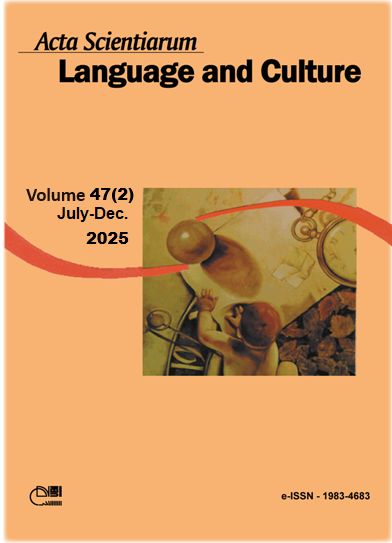Surrealism and madness in the manifestos and the poetry of Xavier Abril
Abstract
. The objective of the article is to analyze the relationship between surrealism and madness in the manifestos and poetry of the Peruvian author Xavier Abril (1905-1990). For this reason, the social and cultural context where poetic avant-garde arises in Peru is characterized, which has the following tendencies: the cosmopolitan avant-garde (represented by Martín Adán, Alberto Hidalgo, among others) and the indigenous avant-garde (whose exponents are César Vallejo, Alejandro Peralta and other poets) Likewise, the surrealist manifestos and some of the most representative poems of Difícil Trabajo de Abril are addressed in order to carry out a hermeneutical analysis that highlights the association between the surrealist metaphor, the dream component and madness. Furthermore, there are two types of madness in Abril's poetic work: that associated with the imagination and that linked to dehumanization in modern capitalist society. The theoretical framework used in the hermeneutical analysis is the General Textual Rhetoric of the Italian theorist Giovanni Bottiroli, above all, the concept of figural province. This is how we talk about metaphorical, antithetical, synecdochic and metonymic thinking. The approaches of the French philosopher Michel Foucault on madness are also applied in relation to the procedures of exclusion of discourses.
Downloads
References
Abeijón, M. (2017). El concepto de verdad en “Historia de la locura”. Norma y exclusión en relación a la tesis antropológica de Michel Foucault. Nuevo Pensamiento, 7(9), 22-44. https://p3.usal.edu.ar/index.php/nuevopensamiento/article/view/6141
Abril, X. (1929). Estética del sentido en la crítica nueva. Amauta, 24, 49-52.
Abril, X. (1930). Palabras para asegurar una posición dudosa. Bolívar, 12, 6-7.
Abril, X. (2006). Poesía soñada. Fondo Editorial UNMSM.
Bottiroli, G. (1993). Retorica. L’intelligenza figurale nell’arte e nella filosofia. Bollati Boringhieri.
Bottiroli, G. (1997). Teoria dello stile. La Nuova Italia.
Bottiroli, G. (2006). Che cos’è la teoria della letteratura. Einaudi.
Breton, A. (1992). Manifiestos del surrealismo. Labor.
Burga, M., & Flores Galindo, A. (1987). Apogeo y crisis de la república aristocrática. Rikchay.
Chueca, L. (2015). Surrealismo, estética e ideología en El autómata de Xavier Abril. Letras, 86(123), 49-68.
Cisneros, A. (1996). Poesía reunida. Editora Perú.
Eielson, J. (1998). Poesía escrita. Norma.
Fontanier, P. (1977). Les figures du discours. Flammarion.
Foucault, M. (1974). Las palabras y las cosas. Siglo Veintiuno.
Foucault, M. (1979). La arqueología del saber. Siglo Veintiuno.
Foucault, M. (1992). El orden del discurso. Tusquets.
Foucault, M. (2012). Historia de la locura en la época clásica. Fondo de Cultura Económica.
Groupe μ. (1982). Rhétorique générale. Éditions du Seuil.
Horkheimer, M. (2002). Crítica de la razón instrumental. Editorial Trotta.
Lauer, M. (2003). La musa mecánica. Máquinas y poesía en la vanguardia peruana. Instituto de Estudios Peruanos.
López Lenci, Y. (1999). El laboratorio de la vanguardia literaria en el Perú. Horizonte.
Mariátegui, J. C. (1994). Mariátegui total (2 tomos). Amauta.
Moro, C. (2016). Los anteojos de azufre. Sur, librería Anticuaria; Academia Peruana de la Lengua.
Neruda, P. (1997). Residencia en la tierra. Cátedra.
Quijano, A. (1988). Modernidad, identidad y utopía en América Latina. Sociedad y Política Ediciones.
Rimbaud, A. (1992). Una temporada en el infierno (Edición bilingüe, R. Buenaventura, Trad.). Hiperión.
Valenzuela, J. (2008). Xavier Abril y la experiencia de la vanguardia en El autómata y otros relatos. In X. Abril. El autómata y otros relatos (pp. 7-27). Pontificia Universidad Católica del Perú.
Vallejo, C. (1999). Teatro completo I. Pontificia Universidad Católica del Perú.
Vallejo, C. (2002). Ensayos y reportajes completos. Pontificia Universidad Católica del Perú.
Vallejo, C. (2023). Poesía completa. Ediciones Copé.
Westphalen, E. A. (2006). La poesía de Xavier Abril (estudio). In X. Abril, Poesía soñada, (pp. 113-118). Fondo Editorial UNMSM; Academia Peruana de la Lengua y Universidad de San Martín de Porres.
Copyright (c) 2025 Camilo Rubén Fernández-Cozman

This work is licensed under a Creative Commons Attribution 4.0 International License.
DECLARATION OF ORIGINALITY AND COPYRIGHTS
I Declare that current article is original and has not been submitted for publication, in part or in whole, to any other national or international journal.
The copyrights belong exclusively to the authors. Published content is licensed under Creative Commons Attribution 4.0 (CC BY 4.0) guidelines, which allows sharing (copy and distribution of the material in any medium or format) and adaptation (remix, transform, and build upon the material) for any purpose, even commercially, under the terms of attribution.
Read this link for further information on how to use CC BY 4.0 properly.




















6.png)









